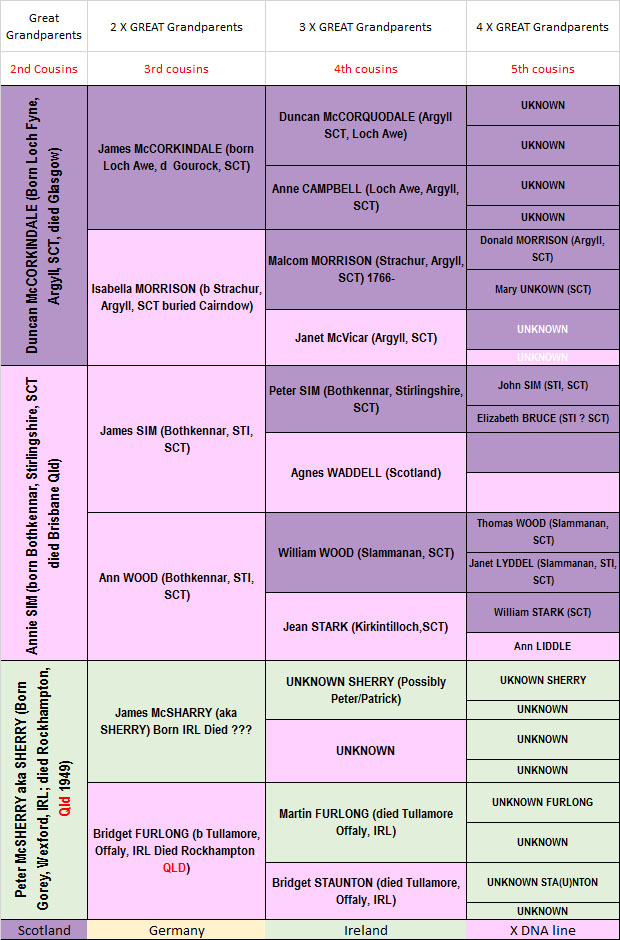Over the weekend I spent some time trying to make sense of a close DNA match that I have on Ancestry and GedMatch. I have a small private tree on Ancestry (reluctantly) and I was able to quickly add names, thanks to my prior research. On Family Tree DNA I use both names and places as my information, and again have added a basic family tree.
I’ve been thinking about this issue for some time and it seems to me that place is at least as important as names. That might seem strange when we are tracing family, and genetic matches will show we are kin. However, with marriage among extended families of siblings, it can be easy to overlook, or simply not know, all the relevant names.
I find that by being able to narrow down common locations, even counties and countries, it enables me to focus on more likely links. Not being a big Ancestry fan I was interested to discover that they have a mapping option on their match links which is actually quite useful.
One thing led to another and I prepared this fan chart which focuses on where children of any given couple were born (click to enlarge). So, if all the children were born in Australia, then it’s going to be beyond that time-frame if I have a US match (unless they have an identified link). This differs from a normal fan chart which identifies the person and may include where they were born – rather it’s where their children were born.

Once back to my overseas families, I can identify where their children may have migrated, and in some cases the dispersal can be quite extensive: US, Australia, England, Ireland, Canada. This helps me to focus on where my matches might overlap.
I’ve also added in the maternal lines which generate X-DNA, as that can narrow the search down as well. Because I’ve got Mum’s DNA tested, I’ve been able to phase Dad’s DNA using mine and Mum’s, again narrowing down which side of the family is relevant.

Thanks to a suggestion from another blogger (sorry, I’ve forgotten now who it was – it may have been this one), I’ve also drawn up an extract of my horizontal pedigree chart which basically maps geography and names in a similar way – the colour coding is in the bottom line. This extract excludes the dates that I send to DNA matches.
A similar, graphically simple chart, initiated by J Paul Hawthorne of Geneaspy blog, is doing the rounds among the Facebook genealogy community this weekend but that focuses on direct lines of ancestry. This is great for snapshot view of your ancestry but only illustrates where one branch of the descendants scattered to around the world, something my fan chart attempts to overcome.

Having said all that, it still often seems difficult to make those ancestral connections. It seems to me there are a couple of potential pitfalls with the matches:
- The DNA has recombined in such a way that one segment has been preserved intact for longer than expected transfers so we’re related more distantly than the testing company projects.
- The matched person may not have been able to take their research back as far due to more limited information on certificates and the like.
- Perhaps those shaky leaves have led to mistaken lines of ancestry. Yes, I’m being judgemental. Because I’ve used certificates and registers to take mine back, generation by generation, I’m 90+% confident of what I’ve documented. Furthermore, DNA matches confirm at least some of these lines….the rest I’ll work on progressively using known links.
- There’s a Non-Paternal-Event (NPE) ie an unknown illegitimacy or obscured parentage.
Have you found place to be valuable when making your DNA connections?
Can you add anything to the list I’ve put forward above as explaining why it’s difficult to make the ancestral linkages?
Does my fan chart make sense to you?
Wow, that is intense. It makes my brain hurt a bit. Not sure I am ready for DNA yet ………..
LikeLiked by 1 person
Pretty sure I’m not either Kerryn!
LikeLike
Neither am I! Because I have so much missing information due to slavery, I just can’t figure it out, unless there is some link to someone that I know about. Place would help too, although lots of people were always moving from here to there and relatives moving elsewhere that I’m not sure it would work, unless it was a place I knew.
Your chart is too small for me to try and figure out. I tried to enlarge, but it didn’t.
LikeLike
I can only imagine the challenges that arise from slavery – I don’t envy you that. However, I do find the same situation where it’s easy to make matches when you already know the connection and the paper trail exists.
Don’t know why the chart wouldn’t enlarge.
LikeLike
I haven’t had any close matches with DNA yet but it seems logical to me to focus on place and the places of birth of all siblings and their offspring (if you know it). I think NPE may have a lot to do with why it might be difficult to make linkages. Depending how far back you go and whether it was obligatory to record births, it may be more difficult the further back you are trying to make the connection. And it seems that in the USA birth registration happened a lot later than here yes?
LikeLike
I know NPE has a big effect in some instances, but when expected cousins match up, that negates the NPE. Where paper trails don’t exist, it just makes it plain difficult – a DNA cousin and I have been trying to narrow down our links and we’ve used place to focus on the likely connection – so far without success. US registration is much more basic (like England) based on what Judy Russell said.
LikeLike